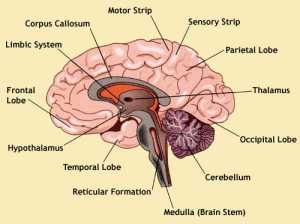I know that many keepers of reptiles believe that their pets love them as much
as they love their reptiles, but because of the reptile brain this is impossible
on the part of the animal. The Boa that seems content to stay curled up on your lap,
or the one that is draped across the back of your shoulders is merely seeking out the warmth of your body, or using you as it would use a tree in getting a better vantage point, nothing more. The reptile keeper is being anthropomorphic when he says that a reptile can show affection towards it's human care-giver. Reptile keepers have a need to believe that their chosen animal can love them back.
In his own words a herper says, "Ball python behavior is really based on only a
few things. Hunger, security, and their unbelievable curiosity. At least
I consider it curiosity, I don't know what else to call it. Do take into
consideration that snakes can't read and really don't care what I've written here.
Ours continue to do things that amaze us. It becomes more obvious with the more
snakes you have that each one does have some sort of personality. Also remember
that snakes are very low on the intelligence level, most things that they do are
simply out of natural instinct, or possibly habit. A lot of people like to
anthropomorphize human emotions onto their snakes, thinking that the snake
likes to cuddle, etc... Snakes, as far as scientific studies have shown, do not
feel emotions like we do".

Using a diagram of the human brain to explain how the reptilian brain
functions as compared to the mammalian brain.
Consider your brain as having three parts: 1) Thinking, 2) Feeling, 3) Action.
The thinking part, called the neocortex, or the neocortical brain. In evolutionary
terms, this is the most recent part of ourselves that has been developed – "most
recent" meaning the last 10,000 years!
The feeling part, called the limbic, or limbic part. In evolutionary terms, this
part has been with us from the beginning. Think of the limbic system like a
gyroscope of emotional response.
The action part of us is called the reptilian, or basic brain. In evolutionary
terms, this is the most fundamental part of us. Our basic brain reacts very
quickly to threats (real or imagined).
The Reptilian Brain is the very center of our brain, the brain stem and those
parts immediately attached to it.
Brain Stem: Arousal And Basic Life Functions
WHERE IS IT?: When the spinal cord enters the skull through a hole in the bottom
called the FORAMEN MAGNUM, it becomes the BRAIN STEM. The spinal cord and BRAIN STEM
merge into one another. The BRAIN STEM is basically a small enlargement of the
spinal cord. It is about the size of your little finger and rests at the very
base of the brain, supporting it like a stem for a flower. There are three parts
to the BRAIN STEM from the bottom up: the MEDULLA, the PONS, and the MIDBRAIN.
WHAT DOES IT DO?: The BRAIN STEM is the oldest and deepest part of the human
brain, having evolved more than five hundred million years ago -- long before
there were humans on earth. Scientists sometimes call it the "Reptilian Brain"
because it resembles the simple brain of a reptile.
The BRAIN STEM has two main functions: (1) BASIC LIFE FUNCTIONS through the
respiratory and cardiac centers in the lower part, the MEDULLA, and (2)
AROUSAL through the RETICULAR ACTIVATING SYSTEM that stretches throughout the
BRAIN STEM. The RETICULAR ACTIVATING SYSTEM alerts the thinking part of the
brain, the CORTEX (located at the very outside of the brain), like a telephone
bell, letting it know that information is going to arrive.
Put another way:
REPTILIAN SYSTEM OR 'R-COMPLEX' (this is the brain of all reptiles and amphibians)
The oldest layer of the human brain and therefore
the most 'primitive' of the three is known as the 'reptilian system' because it
makes up the entire brain mass in reptiles. The reptilian system, also known as
the 'root brain' or 'R-complex' consists largely of the brain stem, the basal
ganglia, the reticular activating system and the midbrain. Functions of the
R-complex are related to physical survival and body maintenance - digestion,
reproduction, circulation, breathing, response to stress, and so on. The functioning
of the R-complex is related to the instinctive so-called 'primitive' behaviour
patterns associated with self- preservation including automatic behaviours of
territoriality, social dominance, status maintenance, deception, tendency to follow
precedent, awe for authority, social pecking order behaviour, compulsiveness,
ritualism, prejudice and resistance to change. The R-complex is activated when
the organism perceives threat and the needs for survival and safety predominate.
MAMMALIAN BRAIN OR THE 'LIMBIC BRAIN' (this is the brain of all birds and mammals,
including rats)
The second layer occupies the lower fifth
of the human brain and is known as the 'mammalian brain' because it developed as
mammals developed from reptiles.The mammalian brain consists of a series of brain
structures - hippocampus, amygdala, mammilary body, anterior thalamus, cingulate
cortex and hypothalamus - which together form a cap or 'limbus' (Latin for 'ring'
or 'forming a border around') around the brainstem containing the R-Complex.
Hence the name 'limbic' brain. Like the R-complex, the limbic brain is concerned
primarily with self-preservation and species-preservation and controls the
autonomic nervous system. The limbic system functions in primal activities
related to food and sex, and in activities related to the expression and mediation
of emotions and feelings, including emotions linked to the attachment and care of
young. It is involved with functions which are closely related to emotional
behaviours including play, rearing of young and sense of self. The amygdala
functions in the association of events with emotion. The hippocampus
functions in spatial memory.
The limbic system has extensive influence on human behaviour because all its
components are connected to the hypothalamus.
When the limbic system interacts with the cerebral cortex - thinking part of
the brain - then feelings of fear and protection become increasingly complex.
Of particular significance for the learning process is the role of the limbic
system in sense perception and memory. It monitors sensory input, converting it
into appropriate modes for processing and directs it to the appropriate memory
storage system. Neurochemicals in the limbic system are instrumental in the
transfer of memory from short-term to long-term storage which takes thirty seconds.
CEREBRAL CORTEX OR NEOCORTEX OR NEO-MAMMALIAN BRAIN (all mammals possess a small part
of this third layer, however, it is the largest part of the brain and is reserved for
humans and our primate cousins)
The third layer occupies five sixths of the brain and is known as the 'neomammalian
brain', the 'neocortex' or the 'cerebral cortex'. The cerebral cortex is the
latest evolutionary development of the brain... the distinctively primate and
human layer. The cerebral cortex is involved with most mental activity, including
spatial and mathematical thinking, meditating, dreaming, remembering, processing
and decoding sensory information. The cortex is two millimeters in thickness
and covers the two cerebral hemispheres. The numerous morphological subdivisions
are based on the numerous neurological functions, seat of language, speech,
thought and sensory processing. These include motor-control and some associative
events. Sensory-receiving areas and motor-control areas are well-defined. Areas
involved with associative events are less well-defined. The cerebral cortex is
considered to be the structural and functional 'interface' between input of
environmental stimuli and brain output.
Young reptiles function as miniature versions of adults, but baby mammals and birds are dependent because of their poor capacity to thermo-regulate, the consequence of their need to devote most their energy to growth. Most mammals solve the problem with maternal care, shelter, warmth, and milk. In most birds, both parents cooperate to provide food and shelter to their young. The expanded forebrain and parental care provide mechanisms for the extra-genetic transmission of information from one generation to the next. This transmission results from the close contact with parents during infancy.
The mother alligator digging her babies out of the nest, gently taking them into her gaping jaws, and depositing them at the water's edge, is being driven merely by instinct, "survival of the species" instinct. Her Reptile Brain will not allow her the joy of the maternal instinct that is reserved for mammals.
So when it is all said and done, it still begs the question, at least for me...
Why are humans so attracted to keeping reptiles as pets? Because of the primitive aspects of the reptilian brain, reptiles and amphibians can never be domesticated. Their very nature will not allow it.
Your input is appreciated.
I find reptiles to be facinating and beautiful creatures...in the wild. Sandra B.
References For This Page:
Image of Iguana:
Classroom Clipart
Image of Human Brain:
Alberta Brain Injury Help Line
In the Herper's own words:
The Reptile Rooms
Body of this page:
addEQ-Brain
Building a Brain From the Bottom Up
The Three Layered or "Triune" Brain
Multicellular Organisms
TOP OF PAGE
BACK TO SNAKEFOOD
BACK TO ABOUT ME
HOME

This site is being created by Sandra Beasley
Copyright © 2002-the present time
All Rights Reserved



